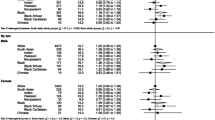Abstract
Background: There have been conflicting reports of increased incidence of childhood leukemia in the United States with some, but not other, registries reporting increasing rates over the past two decades. Because of the reported discrepancy in childhood leukemia incidence rates an analysis of the SEER database was undertaken.
Methods: The latest SEER data (1973–1995) were analyzed for trends in childhood (age 0–14) leukemia incidence rates by histologic group (all leukemia combined, acute lymphocytic leukemia (ALL), acute mylogenous leukemia (AML), and other acute leukemia) for each SEER reporting region.
Results: A significant increase in ALL during 1973–1995 was observed in the combined SEER data, but the increase was a function of whether the first 3 years, data from the SEER Detroit reporting region are included. For the years 1973–1975 the Detroit region reported to much lower rates for ALL and much higher rates for “other acute leukemias” relative to the other SEER regions, resulting in an exaggerated temporal increase in ALL.
Conclusion: Excluding both the temporal variability, and coding differences for Detroit in the 1973–1975 time frame, there has been no significant increase in childhood leukemia of any histologic group or age category in the United States from the 1970s to 1990s.
Similar content being viewed by others
References
SEER. Surveillance Epidemiology and End Results Cancer Statistics Review: 1973-1994 (1997). Ries LAG, Kosary CL, Hankeys BF, Harras A, Miller BA, and Edwards BK, eds., No. 97-2789. Bethesda, MD: National Cancer Institute, National Institutes of Health.
Gurney JG, Davis S, Severson RK, Fang J, Ross JA, Robison LL (1996) Trends in cancer incidence among children in the U.S. Cancer 78: 532–541.
Zahm SH, Devesa SS (1995) Childhood cancer: Overview of incidence trends and environmental carcinogenesis. Environ health Perspect 103 (suppl.): 177–184.
Schmidt CW (1998) Childhood cancer: a growing problem. Environ Health Perspect 106: A18–25.
Linet MS, Ries LAG, Smith MA, Tarone RE, Devesa SS (1999) Cancer of Surveillance Series: recent trends in childhood cancer incidence and mortality in the United States. J Natl Cancer Inst 91: 1051–1058.
Bunin GR, Feuer EJ, Witman PA, Meadows AT (1996) Increasing incidence of childhood cancer: report of 20 years experience from the Greater Delaware Valley Pediatric Tumor Registry. Paediatr Perinat Epidemiol 10: 319–338.
Devesa SS, Blot WJ, Stone BJ, Miller BA, Tarone RE, Fraumeni JF (1995) Recent trends in the United States. J Natl Cancer Inst 87: 175–182.
Draper GJ, Kroll ME, Stiller CA (1994) Childhood cancer. Cancer Surveys, vol. 19/20: Trends in Cancer Incidence and Mortality, pp. 493–517.
Miller RW (1992) Childhood leukemia and neonatal exposure to lighting in nurseries. Cancer Causes Control 3: 581–582.
Smith MA, Freidlin B, Gloeckler LA, Simon R (1998) Trends in reported incidence of primary malignant brain tumors in children in the United States. J Natl Cancer Inst 90: 1269–1277.
Author information
Authors and Affiliations
Rights and permissions
About this article
Cite this article
Liberson, G.L., Golden, R.J., Blot, W.J. et al. An examination of the sensitivity of reported trends in childhood leukemia incidence rates to geographic location and diagnostic coding (United States). Cancer Causes Control 11, 413–417 (2000). https://doi.org/10.1023/A:1008940107404
Issue Date:
DOI: https://doi.org/10.1023/A:1008940107404




